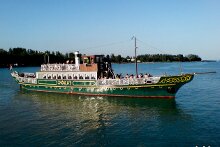Lake Balaton
 Lake Balaton or Balaton in short, is the largest lake in Central Europe, which is situated in the Middle Transdanubian region in the western part of Hungary. The 77 km length and the 14 km width form a 600 square kilometer water surface. The Tihany peninsula divides the lake into two parts, forming a strait – with only about 1 km to sail across – which is also the deepest point of the Lake (11 meters). This part is known as the ’Tihany Well’ and it is caused by the periodical stream of the longitudinal movement of the water due to the E-W or W-E winds. The main axis of the lake lies approximately in a SW-NE direction. Compared to the Alpine lakes of Central Europe, Lake Balaton is shallow. The water depth varies between 0.5 and 5 meters. It is shallower on the Southern shore, becoming 2 meters deep only at around 600-1000 meters distance from the shore. On the hilly Northern shore the depth starts with about 1.5 m and reaches the above mentioned 5 meters relatively soon.
Lake Balaton or Balaton in short, is the largest lake in Central Europe, which is situated in the Middle Transdanubian region in the western part of Hungary. The 77 km length and the 14 km width form a 600 square kilometer water surface. The Tihany peninsula divides the lake into two parts, forming a strait – with only about 1 km to sail across – which is also the deepest point of the Lake (11 meters). This part is known as the ’Tihany Well’ and it is caused by the periodical stream of the longitudinal movement of the water due to the E-W or W-E winds. The main axis of the lake lies approximately in a SW-NE direction. Compared to the Alpine lakes of Central Europe, Lake Balaton is shallow. The water depth varies between 0.5 and 5 meters. It is shallower on the Southern shore, becoming 2 meters deep only at around 600-1000 meters distance from the shore. On the hilly Northern shore the depth starts with about 1.5 m and reaches the above mentioned 5 meters relatively soon.
Wave pattern
The wave pattern of Lake Balaton is very special. Due to the shallowness of the Lake, the short and relatively high waves can be very rough when the wind is blowing. The wave length is 3-4 meters, reaching up to 6 meters in strong wind. The height of the waves is usually 1 meter, but in strong wind it may reach 1.5 meters and the crests fall through. In very rare circumstances, over a 80 km/hour wind speed, the wave crests disappear and the water starts to form a dusting steam, which is very dangerous. Due to the shallow water, the lake warms up quite rapidly and in the summer, it may reach 25 degrees Celsius, while the air temperature might reach about 30-35 degrees Celsius. In the winter the Lake freezes up and becomes an excellent ice-skating resort.
Wind
The prevailing wind direction is in 40-45% N-NW, which means, it is about perpendicular to the main axis of the Lake. Its velocities vary statistically balanced in 10% 0-1.5; in 60% 1.5-8; and in 30% 8-14 m/s. The other wind directions are statistically balanced and specified by less than 8 m/s. However, the hilly coastal formations with its deep valleys on the Northern shore can cause sudden changes both in strength and direction. Anyhow, it has to be noted that although Balaton is only a lake, during storms it could become very dangerous. In order to minimize the risk, from 1 March to the end of October there is a storm-warning service with flashing lights all around the Lake. In case of approaching storms, the yellow light flashes 45 times per minute, and the immediate storm hazard, red-alert, is signaled by 90 times per minute flashing, meaning that bathers and smaller boats must go to the shore as soon as possible.
Source of the picture: http://www.eoearth.org
More information is available here





